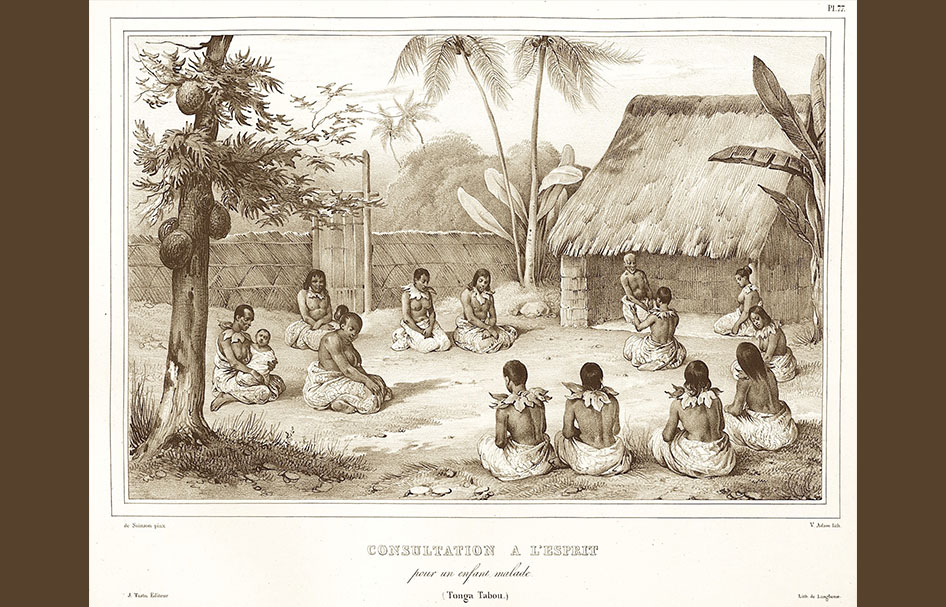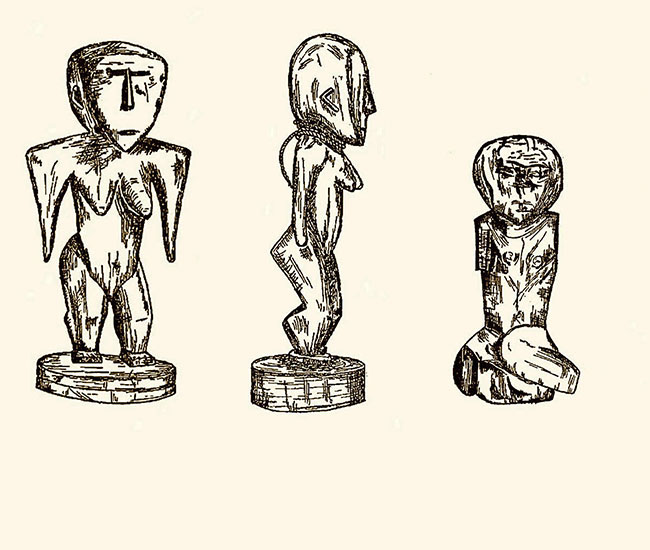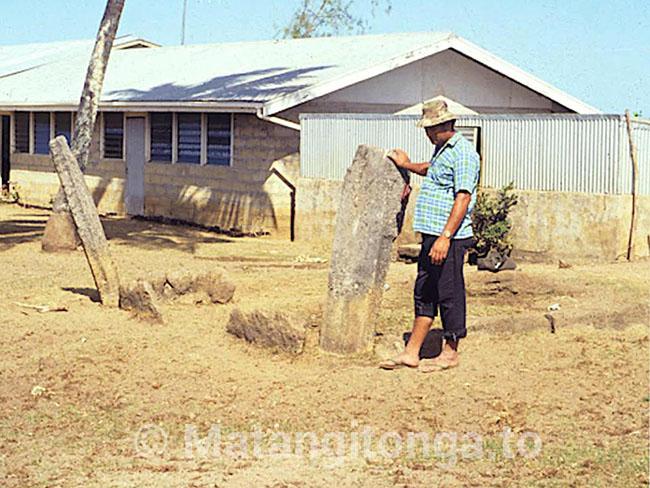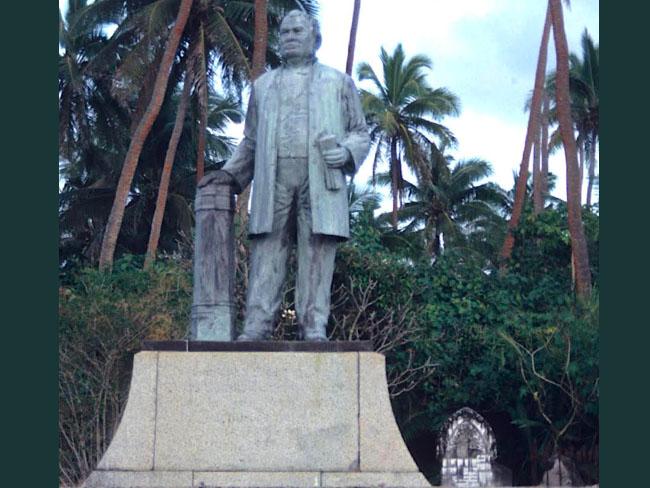
Lithograph by Louis de Sainson, artist on the 1826 visit to Tongatapu by the French expedition under Jules Dumont d’Urville. This portrays a consultation on behalf of a sick child with the priest in the sacred enclosure of a Fale ‘Otua. The lithograph was published in 1833 as Plate 77 in Voyage de la Corvette L’Astrolabe exécuté pendant les Années 1826-1827 - 1828-1829, Paris.
By David V. Burley
On November 2, 1866, the Reverend Shirley Waldemar Baker, missionary and eventual Prime Minister of Tonga, gave a lecture in which he describes the last traditional God House in Ha'apai. As quoted by Anthropologist Edward Winslow Gifford in his volume on Ancient Tongan Society (1929), the Reverend Baker was to state:
I have stood in the old Fale Mee at Haano, which is the last fale otua (temple of their god) still standing in Haapai. At the foot of the principal post there is buried a man, who was said to be the best singer in all Tonga. He was offered a living sacrifice to the god at the building of the temple, as an act of dedication.
Ha'ano, Ha'apai
On July 15, 1991, I too stood in the temple of Fale Me'e, it then being located to the front of the primary school in the village of Ha'ano. The temple’s corner posts and wall footings were made of quarried beach rock. Two of the posts remained standing, one had fallen to the side, and the fourth, ironically, had been removed in 1983 to hold a commemoration plaque for the opening of a new Wesleyan Church.

Fale Me'e
When I asked questions about the standing stones in Ha'ano, I was sent to Semisi Valeli Vake, a much respected motu’a tauhifanua (old one taking care of the land/people). To Vake, this was Fale Mei, built as a grave house for a singer. The singer was very good and people had become jealous. They became so jealous, that they beat him to death, and he was buried at the site. The Baker and Vake stories have a different twist, but enough of the content to identify the house as Fale Me’e.
The village of Ha'ano is the chiefly estate of Tu' Ha'angana, a title of considerable antiquity. Its origins go back to the mid 15th century to Nganatatafu, the younger brother of the 20th Tu'i Tonga, Tatafi'eikimeimu'a. Not long after, one of his descendants constructed Langi Lahi, a large stone-faced tomb with access ramps and memorial stone uprights. Fale Me’e was built close by in association.

Goddess Hikule'o
Gifford collected a second story relating to Fale Me'e in 1920, this time with a bit more detail. The temple, he was told, had been built for the goddess Hikule'o on a tract of land called Fanakava. The priest for the goddess was Manakato. When needed to cure sickness or other types of requests, Manakato could intercede, becoming an oracle through which Hikule'o was able to speak. The cost to appease the goddess were gifts of food, little finger sacrifice or, on occasion, a human life. Fale Me'e and Fanakava became a famous place of refuge where those in peril gained sanctuary.
The ancient pantheon of Tongan deities was large, incorporating several orders of gods. Three were preeminent, kau Tangaloa, the sky gods, kau Maui, the gods of the underworld, and their presumed elder sister, Hikule’o. Hikule’o was goddess of Pulotu, the Tongan afterworld, where the souls of the ancestors came to reside. She was all powerful, with influence over the fertility of the land, weather, and the success of the Tongan people. She was the deity of the sacred King, the Tu'i Tonga. Her principal temple was built at his compound at Olotele in Lapaha, as reported by the Missionary John Thomas. Adjacent to this was Fanakava, the most powerful place of refuge in all of Tonga.
Nganatatafu was of the Tu'i Tonga line, providing an explanation for Fale Me'e and the goddess Hikule’o in Ha'ano. Vake spoke of a close relationship of this site with two others in Ha'apai, one on 'Uiha and the other on Tungua. 'Uiha is the chiefly estate of Malupō, a second title of the Ha’a Ngana. Hikule'o was his goddess as well, her temple built on the tract of land called Taoa. Tungua is the island of the Tamahā, eldest daughter of the Tu'i Tonga fefine. My survey of Tungua in 1996 was able to record an area still called Fanakava.
Human Sacrifice
The construction of Fale Me'e, and the human sacrifice carried out in its consecration, are anticipated in descriptions of the residence for Hikule'o in Pulotu. As again told to Gifford in 1920, her house was made of human bone. Surrounding it, she employed recently deceased individuals as posts for the fence, as supports for the log on which ngatu was made, and as uprights for the gate.
Beyond the use of stone, Fale Me'e was not an elaborate construction, being no more than 4 x 4 m in extent. The size was not atypical, as illustrated in an 1826 lithograph of a Fale 'Otua on Tongatapu. As also illustrated in that lithograph, the temple would have been enclosed by a woven fence, creating a sacred compound for visitors and priest. A carving of the goddess imbued with her essence was kept within the temple space. This was central to the priest’s ability to access her and the supernatural realm.

Tāufa'āhau
The years 1829 to 1830 were critical for Ha'apai. Tāufa'āhau, the Tu'i Ha'apai and later King George Tupou I, became convinced of Christianity. He, with the missionary John Thomas and acolyte Pita Vi, began promoting the new religion throughout the islands. Part of his campaign was to appropriate the traditional gods, disband their priesthood, and burn the god houses. To illustrate the inability of the ancient deities to enact retribution, he defiled and hung their images from the rafters of his house. One of these, presumably Hikule'o, was cut down and given to Reverend John Williams in July of 1830 at Lifuka. Williams took it to England, the sennit cord still attached to its neck. Others were acquired by John Thomas. It is easy to assume that the goddess of Fale Me'e was among this lot.
The singer
Sometime early in 1992, the remains of Fale Me'e unknowingly were destroyed. They had been built over and integrated into a fence to surround the primary school. I have been told that the removal of these stones encountered human remains. The fate of the singer who was sacrificed five hundred years earlier remains unknown.

Dr. David V. Burley is a Professor of Archaeology at Simon Fraser University in Burnaby, BC, Canada. He has carried out archaeological studies in Tonga since 1989.
More articles in this series:
- Ha'apai rock art suggests Hawaiian link about 1400-1600AD
- Tongatapu's astonishing burial mounds
- Giant Tongan fruit-gulping pigeon eaten into extinction
- The last Fale 'Otua in Ha'apai
- 'Ata and its archaeology
- The Lapita origins of Tongan ngatu and design
- Scarcity in Paradise
- Early settlement of Ha‘apai brilliantly laid title to islands
- Taupita –Tonga’s earliest known game
- The first Tongans







